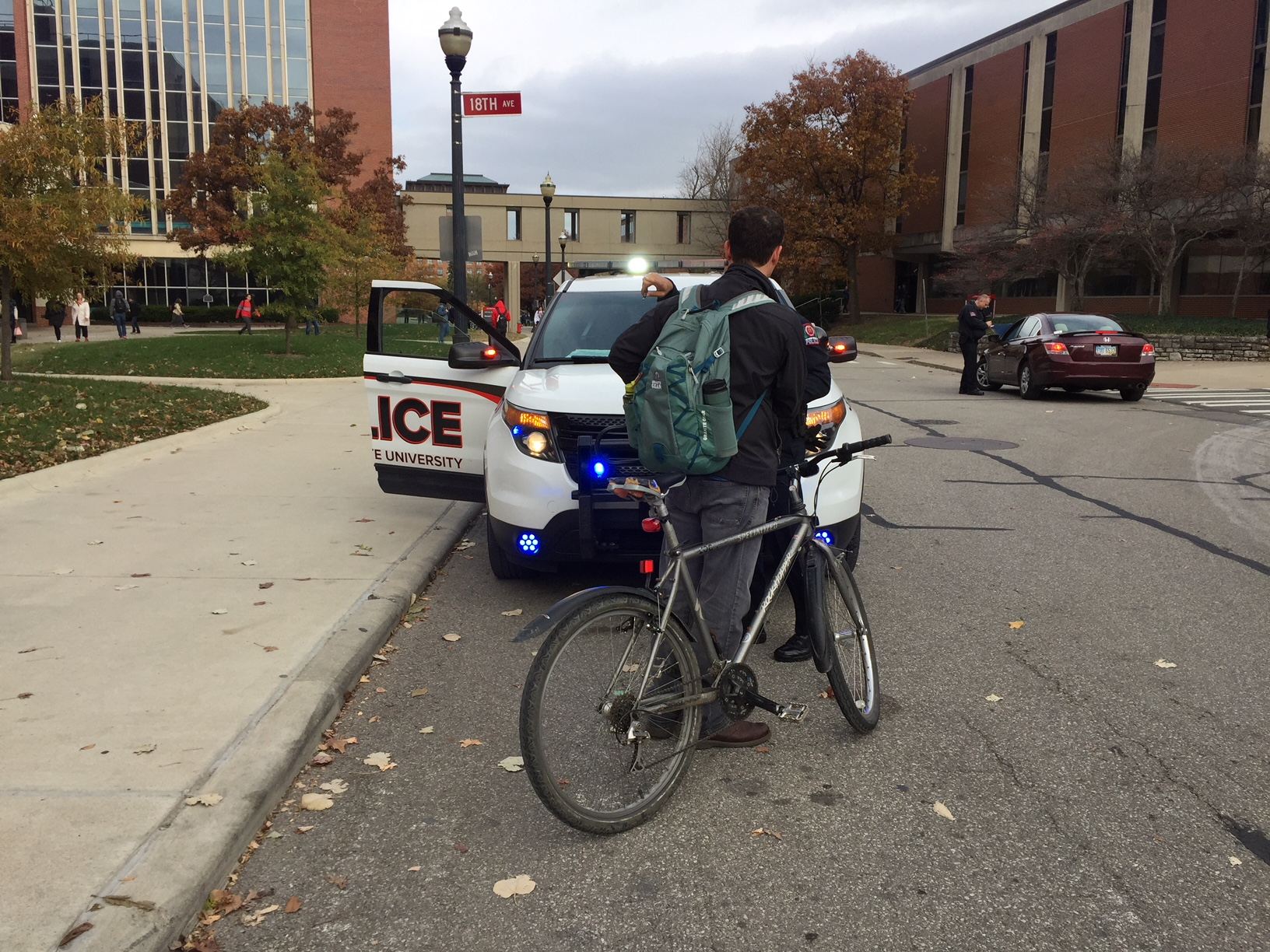
One student cyclist gets pulled over for riding the wrong way down Neil Ave. Credit: Megan Russell | Senior Lantern Reporter
Annalee Sekulic left her job at the Younkin Success Center Nov. 9 and got on her bike to ride back to Torres House, where the second-year in anthropological sciences and public policy lives. About four times per week, Sekulic makes this same trip — north on Neil Avenue, pedaling past Thompson Library, and the red-and-white “Do not enter” sign on Neil Avenue while continuing home.
The trip is typically uneventful. Except this time.
Shortly after crossing West 17th, Sekulic was pulled over by University Police for riding her bike the wrong way on Neil Avenue. It wasn’t only her. On Nov. 9 alone, between 4:13 p.m. and 5:13 p.m., University Police issued formal warnings to 11 people, all students, for the same traffic violation, according to public records.
The spate of violations is part of increased enforcement efforts by University Police to promote law-abiding cycling. The formal warnings do not include a fine. Officers logged the bicyclist’s information and reminded them of traffic laws.
The decision to step up enforcement, particularly in the stretch of Neil Avenue near West 18th Avenue, follows a rise this semester in the number of complaints University Police received about cyclists’ riding behavior. A spike in the number of injury-inducing traffic incidents involving cars and bikes, cars and pedestrians or bikes and pedestrians occurred, as well.
Between July 2016 and September 2016, there were four such incidents. Between July 2017 and September 2017, there were 13.
“When we see those numbers increasing and when we start receiving concerns from the university community, we want to make sure we address it and keep everybody safe,” said Deputy Chief Kimberly Spears-McNatt. “That’s our No. 1 priority.”
While it is always up to the officer’s discretion, Spears-McNatt said to receive an actual ticket cyclists would have to do something “blatant,” such as if they totally disregard a stop sign or if “they intentionally ran someone over with their bike.” In general, she said officers stop riders and issue a warning or just have an educational conversation about the rules of the road.
Under Ohio law, bikes are classified as vehicles, just like cars, which means cyclists cannot text and ride; they must stop at red lights; and, relevantly, they have to go the correct way on one-way streets.
Sekulic said she knew bikes were classified as vehicles and always tried to use common sense to avoid being “a bad cyclist.”
But she said “everybody always biked that way” on Neil Avenue and she rarely — if ever — thought about it being a one-way. She also said she wasn’t totally sure campus roads were enforced the same as, say, Indianola Avenue.
“It’s been like two years of never seeing or hearing of anybody [getting violations], and out of the blue one day they started pulling over people,” Sekulic said.
The way campus law enforcement handles bikers is hardly uniform, said Amelia Neptune, the director of the League of American Bicyclists’ Bicycle Friendly America Program.
Some departments “look the other way,” but for those that do not, Neptune said her organization, which rates how bike-friendly universities are, encourages police to use enforcement as an educational opportunity because some riders, obviously, don’t know they need to follow traffic laws.
After all, when children are learning to ride bikes, many are taught to stay out of the road and ride on sidewalks — advice which for adults, except in certain designated areas in the city of Columbus, is wrong.
Ohio State does have an educational program, called Share the Road, that involves some signage and events. In September, for example, University Police held “Pedal with Police,” which was aimed at theft prevention and learning the rules of the road.
When the officer finished entering Sekulic’s information, Sekulic said one piece of the officer’s departing instructions was to inform her friends that she was issued a formal warning. The goal, of course, being to spread awareness about bike laws and the ramped-up enforcement without having to stop every biker.
Neptune said Ohio State could also improve its bike-friendliness by adding on-road infrastructure, which basically means bike lanes. As of 2015, her organization rates Ohio State as a bronze campus, the fourth-highest mark.
For now, though, University Police’s increased enforcement does not appear to be subsiding. On Friday, around 10:45 a.m., officers were stopping and issuing warnings to more people on Neil Avenue near West 18th Avenue.
Sekulic said she has taken steps to avoid being stopped again. With the temperature dipping, making it less bike-friendly anyways, she’s decided to do more walking.


